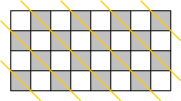

Case 1: {$a$} and {$b$} even.If {$c$} is even, we can divide all the dimensions by two. The resulting box has the same properties as the original box and reduces to this or another case, but on a smaller box. If {$c$} is odd, consider the top of the box. On the top the path will travel on gray squares, going SE-NW and NW-SE.  There is no corner it can reach traveling this way, so the destination must be on the bottom. On the bottom the path travels on gray squares SW-NE and thus can only end at {$110$}. This is as the theorem states ({$c-a$} and {$c-b$} are both odd, hence equally even). |